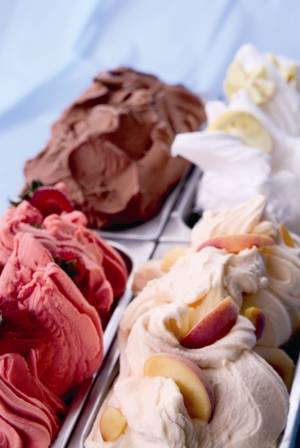Gelato facts for kids
 |
|
| Course | Dessert |
|---|---|
| Place of origin | Italy |
| Region or state | Florence, Tuscany |
| Created by |
|
| Invented | circa 1530 |
| Serving temperature | −14 to −11 °C 7 to 12 °F |
| Main ingredients | |
| Variations | |
| Other information | serve with spade not scoop |
Gelato (pronounced "jeh-LAH-toh") is the Italian word for ice cream. But in English, "gelato" means a special kind of frozen dessert from Italy. It's different from regular ice cream because it has less fat and less air. This makes gelato super dense and full of flavor!
Gelato usually has 6%–9% butterfat, which is less than other frozen desserts. It also has about 35% air, while regular ice cream can have 50% or more. This is why gelato feels so rich and creamy.
Contents
What's in a Name?
In the Italian language, gelato is the general word for any type of ice cream. So, in Italy, all kinds of ice cream are called gelato.
However, in English, the word gelato is used for a special kind of ice cream. It refers to the traditional Italian style, which is often made by hand.
The Sweet History of Gelato
The story of gelato is quite old and interesting! It's part of the bigger history of frozen desserts.
Early Frozen Treats
Around 1295, a famous explorer named Marco Polo came back to Venice from China. He brought with him a recipe that was similar to sorbet. Sorbet is a frozen dessert made with fruit and sugar, but no milk.
Gelato's Italian Roots
Many people helped create the gelato we know today. Two important figures were Cosimo Ruggeri and Bernardo Buontalenti. They lived at the same time as Catherine de' Medici, a powerful Italian noblewoman.
In the 1530s, Catherine de' Medici moved to Paris, France. She is said to have brought gelato with her, introducing this delicious treat to the French court.
The First Gelato Creators
In Florence, Italy, Cosimo Ruggeri is often given credit for making the very first gelato. He created a flavor called fior di latte, which means 'milk flower'. This was a simple, plain gelato made without any eggs. He made it for a cooking contest at Catherine de' Medici's court.
Later, in 1565, Bernardo Buontalenti also made important contributions. He was very good at keeping ice frozen. He created a sorbet with ice and salt, flavored with lemon, wine, milk, sugar, egg, and honey. He also added orange and bergamot flavors. Buontalenti is also known for inventing gelato alla crema, which was an egg cream gelato. This was an early version of the creamy Florentine gelato we enjoy today.
Gelato Goes Global
In 1686, a man from Sicily named Francesco Procopio dei Coltelli brought his grandfather's gelato-making machine to Paris. He opened a famous cafe called Café Procope. This cafe helped introduce gelato to many people. Procopio even got a special license from the French king, Louis XIV, to be the only person allowed to make this frozen dessert in the kingdom.
Modern Gelato Making
Over time, making gelato became easier. In 1904, in America, Emery Thompson built the first machine that could make ice cream automatically.
Later, in 1945, in Bologna, Italy, Bruto Carpigiani started selling machines to make gelato. He created the Motogelatiera, which was the first automated gelato machine. This machine made it much easier to store frozen desserts. Today, Carpigiani is a very big company that makes gelato machines.
In Italy, more than 55% of the gelato sold is still made by hand, not in big factories. This shows how important traditional, artisanal gelato is there.
How Gelato is Made
Making gelato involves a few steps to get its smooth texture.
The Process
First, the ingredients are heated to about 85 degrees Celsius (185 degrees Fahrenheit). This step is called pasteurization, and it makes sure the gelato is safe to eat. After heating, the mixture is quickly cooled down to about 5 degrees Celsius (41 degrees Fahrenheit). Then, it is mixed until it gets the right creamy texture.
Some gelato is made using a "cold process." This means the ingredients are mixed and then frozen in a special machine. There's also a "sprint" process, where milk or water is added to a pre-made mix, then it's blended and frozen.
Why Gelato Stays Smooth
The sugar in gelato is very important. It stops the water from freezing completely solid. The sugar binds to the water, which prevents large ice crystals from forming. This creates many tiny ice crystals, making gelato super smooth and creamy.
Commercial gelatos often use different types of sugar, like inverted sugar, sucrose, dextrose, or xylitol. Sometimes, they also add a stabilizer like guar gum to help keep the texture perfect.
Delicious Gelato Flavors
Gelato comes in many amazing flavors, both traditional and new!
Classic Flavors
One of the first and most basic flavors is fior di latte. This means 'milk flower' in Italian. It's a plain, simple base gelato with no added flavors or eggs.
Stracciatella is another popular flavor. It's made by adding chocolate chunks to fior di latte gelato.
Traditional gelato flavors include cream (sometimes called custard), vanilla, chocolate, hazelnut, almond, and pistachio.
Modern Flavors
Today, you can find many modern and fruity gelato flavors. These include raspberry, strawberry, apple, lemon, pineapple, and black raspberry. There's a flavor for everyone!
See also
 In Spanish: Gelato para niños
In Spanish: Gelato para niños

